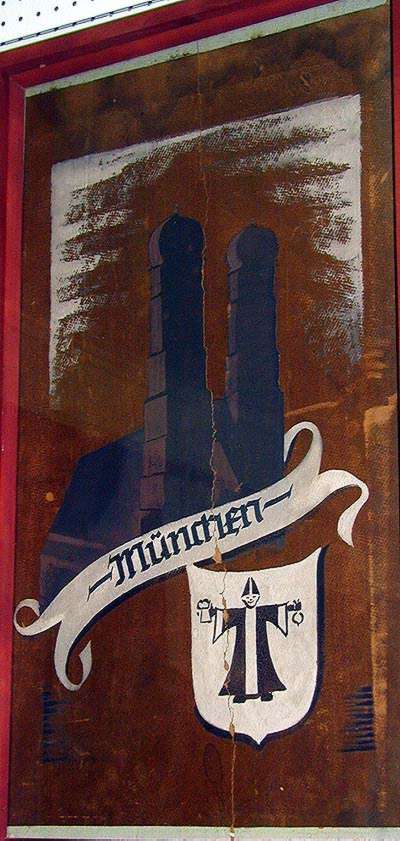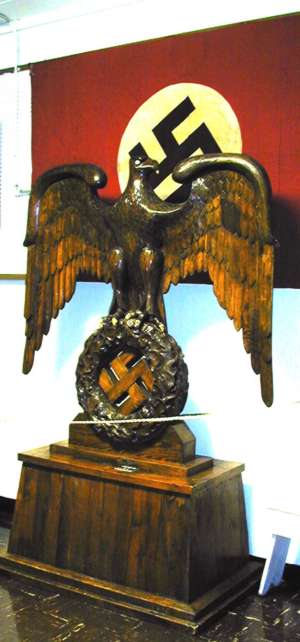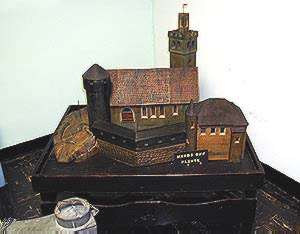|
Moderated by NW Okie! |
Volume 17 , Issue 22015Weekly eZine: (374 subscribers)Subscribe | Unsubscribe Using Desktop... |
German POW Murals In Oklahoma

A Waynoka couple find murals behind walls according to a story that ran in The Sunday Oklahoman, July 4, 1982, and written by Carolyn B Leonard, Waynoka Couple Find Murals Behind Walls."
 Monte and Rosalind Lopshine bought ten lots and two old ramshackle apartment buildings August, 1981. When they were remodeling in May, 1982 they found 24 paintings painted by a German prisoner of war that resemble tour posters with scenes of Austria and the Berlin area. The paintings were found between the studs of one of the old buildings.
Monte and Rosalind Lopshine bought ten lots and two old ramshackle apartment buildings August, 1981. When they were remodeling in May, 1982 they found 24 paintings painted by a German prisoner of war that resemble tour posters with scenes of Austria and the Berlin area. The paintings were found between the studs of one of the old buildings.
The two apartment buildings were originally one long barrack for the POWs held at the Alva Camp during WWII. C. E. Buckner bought one of the barracks, chopped it in half and moved it to Waynoka back in 1945. The property changed hands a few times before the Lopshires bought it in 1981.
The article stated, "Buckner set the the building halves on two separate foundations, added a floor and ceiling and converted the edifice into four apartments. He knew the paintings were there 30 years ago, but he covered them with sheetrock. Buckner said he never thought to mention it when the building changed owners through the years ... At the time, we were not impressed with pictures of Germany. We were tired of the war."
Most of the paintings were found in perfect condition with only a few shows of water-stained reminders of a leaking roof and cracked paint on another.
 The paintings measured about 19 by 34 inches and were painted on masonite between the wall studs using three colors of oil (burnt sienna, cobalt blue, and white).
The paintings measured about 19 by 34 inches and were painted on masonite between the wall studs using three colors of oil (burnt sienna, cobalt blue, and white).
The article quoted Mrs. Lopshires, "There is one older man who lived around here that said he helped tear the camp down. He said there were some whole-wall murals, but when he tried to save them the supervisor told him there was not time for that. They were just working by the hour and had to get it done, so those were destroyed."
Millard Curtis was quoted as saying, "I haven't thought about it for ages, but I remember the paintings. They were in the work building, I think it was."
 The article stated, "The Lopshires, who recently converted one of the buildings into a beer tavern, have plans to turn the old barracks into a German beer garden with an outdoor restaurant adjoining.
The article stated, "The Lopshires, who recently converted one of the buildings into a beer tavern, have plans to turn the old barracks into a German beer garden with an outdoor restaurant adjoining.
 Some other art work (sculptures) that the German POWs did was a six-foot, walnut eagle carved from packing crates and stood in the German Officers POW compound during WWII. It now has a home in the Cherokee Strip Museum at Alva, Oklahoma along with other artifacts of Alva's POW Camp during World War II.
Some other art work (sculptures) that the German POWs did was a six-foot, walnut eagle carved from packing crates and stood in the German Officers POW compound during WWII. It now has a home in the Cherokee Strip Museum at Alva, Oklahoma along with other artifacts of Alva's POW Camp during World War II.
 This German, medieval castle was hand-carved from scraps of wood by one of the German POWs from his memory of his homeland.
This German, medieval castle was hand-carved from scraps of wood by one of the German POWs from his memory of his homeland.
These art collections were created under difficult circumstances and have had a spiritually and romantically value placed on them. None of the paintings were ever signed. The Lopshires and a lot of Woods Countians in NW Oklahoma would love to discover the artist after all these years to fill in the blanks of what is not there anymore.
| View or Add Comments (1 Comments)
| Receive
updates ( subscribers) |
Unsubscribe
| © . Linda Mcgill Wagner - began © 1999 Contact Me | |
